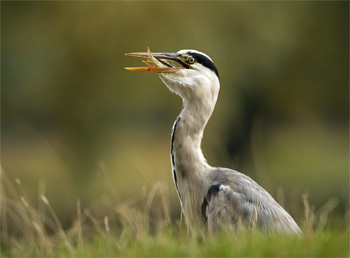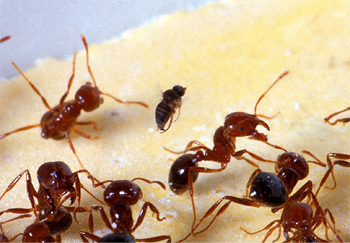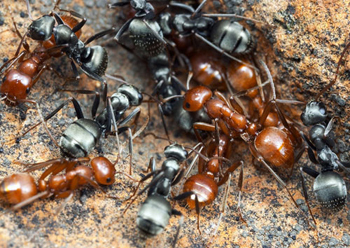5 More Creepy Ways Animals Have Mastered Mind Control
If you want to invade and dominate the thoughts of another living being, you better have a psychic helmet or a fedora, because mind control is the realm of science fiction and ill-advised dating manuals. It's pure fantasy ... at least, for humans. Nature has had mind control on lockdown for millennia. We've tried to warn you about the impending threat of nature's psychic warriors before, but you didn't listen. You must heed our words this time, for -- shh, they grow closer! No. No! We thought we had more time! Quick, flee and tell the world! Tell them about ...
Flukes That Turn California Killifish Suicidal

The Euhaplorchis californiensis is a trematode, or a fluke (if you're nasty). These parasites reproduce only inside the belly of a bird, but since they live underwater and are all but microscopic, that's kind of a tall task. Enter the California killifish, who lives up to its name by being killed in one of the worst ways imaginable -- via parasitic fluke eating away at its brain until it mindlessly offers itself to a hungry avian.

"You should have stayed in school."
The trematode infiltrates the killifish and sets up camp in the brain. But one fluke isn't enough to turn a killifish into a mindless zombie -- for that, it needs an army of thousands. Thousands of murderous, brain-altering parasites. It's like the headquarters of TMZ up in this poor fish's head.
As the flukes set up shop in the fish's brain-meat, they form cysts. This actually affects very little, since it's not like the fish was solving complex physics problems or anything. It's a damn fish. It continues on with life as usual, eating and reproducing, unaware that the trematodes have tweaked one vital behavior that will almost certainly end up killing it.

It hits the killifish kill switch, located just southwest of the worm detector.
See, the trematodes' first act of mind control is to regulate the fish's serotonin and dopamine levels, giving it no reason to swim away when there's danger afoot. Next up, the part of the brain responsible for locomotion is ramped up to an absurd degree, forcing the fish into wild herky-jerky movements that attract a lot of attention from a lot of predators. The killifish swim near the surface, rendered unaware of danger by the fluke's chemical cocktail, where they execute a series of attention-grabbing turns and are devoured by predatory birds. The trematodes get their new home, the bird gets an easy meal, and the fish gets to go fuck itself. Hey, nature is a competition. There's always a last place.
Flies That Terrorize Fire Ants and Birth Babies Inside Their Heads
Pseudacteon is a type of phorid fly whose means of procreation are somehow more horrifying than its already ominous-sounding name portends. Fire ants, nature's screaming middle finger to humanity's ankles, are instinctively scared of the flies. Imagine! Mere flies, terrifying the mighty fire ant -- that's like finding out the Balrog is scared of ladybugs. But the ants have good reason: Pseudacteon is a mind-controlling parasite that preys exclusively on the fire ant. Once this fly shows up on the scene, instinctual fear kicks in and sends the fire ants running for cover.

Barely stopping to kill and devour even one victim on the way.
Only one problem: Pseudacteon finds fear ... erotic. The flies do their fly-nasty, the females get pregnant, and the couple celebrates by planting the newest member of their family straight into a nearby ant's thorax.
Once inside, the larva slowly eats its way from the thorax to the head, then, as a dessert course, Pseudacteon eats the ant's goddamn brain. The brainless ant then stumbles about, continuing to live for a time, but with no will of its own. Yes, this is a zombie-making parasite with a literal hunger for brains. You go ahead and tell Pseudacteon it's a cliche -- we'll be waiting behind the couch to see how that works out for you. Eventually, the larva grows weary of mocking the corpses of its victims and devours the membrane that keeps the ant's head attached to its body, decapitating the poor creature.

"At least our relationship ended on a clean break."
It uses the hollowed-out skull of the ant as a macabre sort of crib, until it grows too large, and then ...
Ah, the miracle of childbirth.
Dinocampus Coccinellae Turns Ladybugs into Crippled Living Cocoons
Despite being both poisonous and carnivorous, we all love ladybugs because bright colors, polka-dots and roly-polyness knock off about 20 IQ points each. The parasitic wasp Dinocampus coccinellae, however, looks at the adorable wittle wadybug and sees only a clubhouse for its children. Just gotta get rid of those pesky organs to make room for a rope-swing.

"It's cramped, but the last owner put a helluva paint job on it."
When it's time for a female to lay her single egg, she does so inside an unsuspecting ladybug, and then flies away, off to continue making the world just a little bit worse simply by existing, as is the prerogative of all wasps. The wasp larva then begins to feed directly off of the ladybug's nutrients and body fat, until it's big and strong enough to completely immobilize its host. It does so by destroying the nerves that control the ladybug's legs, paralyzing it but not killing it. Death is a mercy that nature just does not have time for.
The larva then burrows out of the ladybug's rear and spins a cocoon for itself underneath the ladybug's now-useless legs. The ladybug's bright color (remember: poisonous) acts as a deterrent to any possible predators, thereby keeping its tormenter safe and sound. The ladybug has, in effect, become little more than an immobile fortress -- a living, self-aware, completely petrified Technodrome.

"Kuhll muh ... Kuhll muh ..."
Once it's time to leave the nest, the wasp flies away without even so much as a "sorry about your gaping anus," and goes off in search of another ladybug to murder by birth. (This wasp can procreate within an hour of birth, because life is not a miracle; it is a process of repeating damnation.)
Parasitic Ants Force Other Ants into Slavery

Remember the old fable about the ant and the grasshopper? If not, we'll sum it up for you: The ant works hard all summer and is rewarded with food all winter, while the grasshopper goes on Grasshopper Welfare, spends his days playing Xbox, and eventually starves to death because Hot Pockets don't have any vitamins. It's a fine fable, really shows the kids that you reap what you sow. But it's just a story. Now, imagine that the grasshopper has been replaced by an unstoppable Terminator who also doesn't like work, but is basically fucking invincible, so he just forces the stupid little ants to work for him anyway. That is not a story. That is the reality of Polyergus breviceps, the slaver ant.

The reds are the slavers. The blacks are the slaves, shockingly.
P. breviceps is a social parasite, a red ant species that literally can't function on its own. They can't hunt, they can't feed themselves, they're pretty much the ant equivalent of your shitty college roommate, Chaz. Even their queens are incapable of raising their own babies, so this species regularly invades other, harder-working ant colonies and forces the residents there to pick their food for them, raise their kids, and just generally do their bidding.
P. breviceps starts by sending in their pregnant queen, who unleashes a potent sex pheromone that seduces the soon-to-be slave ants, rendering them horny and extremely open to suggestion. While the soldiers are busy gawking at all the hot, twitching thorax in front of them, the queen tracks down the soon-to-be-slave ants' own queen and brutally murders her. Now ruler-less, the slave ants will quickly accept the P. breviceps queen as their own -- because while she may be lazy, abusive, and evil, it's better than being alone.

And she'll do all of them. That counts for something.
Eventually, as the slave ants drop from exhaustion or fall to predators while out running errands for their sexy evil queen, the mound is completely taken over by other P. breviceps. When there are no slaves left, the slavers move on to another colony, and the process starts again. It's the circle of life, as covered by Danzig.
The Hz-2v Virus Turns Female Moths into Sex-Crazed Zombies
Helicoverpa zea is pretty normal, as far as moths go. At least until the Hz-2v virus comes a-courtin'. We say "courting," because this virus' very existence depends on ensuring H. zea gets its fuck on as hard as mothly possible. It is a moth matin' matchmaker. Which wouldn't be so bad, except that it is, of course, terribly, terribly bad.

Spoiler: She dies. She dies, horribly.
Typically, a female will mate with a male, and then that's it. Encounter over. Ain't no such thing as moth marriage. Hate the game, not the player, lady-moths. But infected females turn into quite the cheeky monkeys indeed, secreting up to seven times more pheromones than usual, attracting just about every male in the vicinity.
None are turned away, though few end up satisfied with the romp. The virus forms a "plug" over the lady's lady-parts, rendering them unable to actually mate. But, of course, no sex doesn't mean no infection: Just the attempt at mating infects the male. As soon as infection occurs, she shoos him away and moves on to the next guy. Meanwhile, the unsatisfied male flits away to find a female that's not such a pupae-tease, and he, in turn, infects her. Thanks to the virus' control on the new moth's brain, she too will likely do nothing but have quick, robotic, passionless, and uncompleted sex until the day she drops dead.

The scientific name for this process is death by snu-snu.
Yep: There's a virus that makes creatures into shameless hussies that have hundreds of unsatisfying sexual encounters until they finally just eventually die.
It's amazing they didn't name it after your mom.
Himanshu could be found shouting obscenities at the internet on Twitter
Always on the go but can't get enough of Cracked? We have an Android app and iOS reader for you to pick from so you never miss another article.
Related Reading: If the animal kingdom hasn't yet sketched you out enough, why not check out the terrible spawn of the Elephant shark? Before we get too horrified at mother nature, let's not forget the nightmares even well-meaning humans can spawn. And hey, why stop the nightmare train there? We have so horrible artificial animals to show you.









